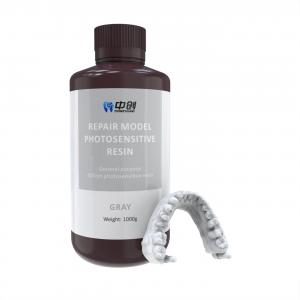
Add to Cart
Specification
| parameter | Test standards | unit | result |
| Shore | ASTM D2240 | Shore D | 76 |
| Bending strength | ASTM D790 | Mpa | 75-82 |
| Bending modulus | ASTM D790 | Mpa | 2050-2215 |
| Notch impact strength | ASTM D256 | Mpa | 36-41.5 |
| Breaking elongation rate | ASTM D638 | % | 7-9 |
| Water absorption rate | ASTM D570 | % | 0.7-0.95 |
| Hot deformation temperature | / | ℃ | <75 |
Description
Biocompatible DLP Resin for Dentures,Prioritize safety with our biocompatible resin, suitable for dentures and patient-centric dental models. Its compatibility with DLP and LCD printers ensures streamlined repair processes while maintaining user and patient well-being.
Product features:
Applicaton
FAQ
1. What is the average curing time for dental model resin during the repair process?
Answer: The curing time can vary depending on factors like the resin type and the curing method used. Typically, dental model resin for repairing offers fast forming speeds, with curing times ranging from a few minutes to around an hour.
2. How does the surface hardness of dental model resin affect the longevity of repairs?
Answer: Dental model resin designed for repairs often boasts high surface hardness, ensuring durability and resistance to wear over time. This hardness contributes to the longevity of repairs, providing lasting results that withstand daily use and manipulation.
3. What post-treatment procedures are typically involved after using dental model resin for repairs?
Answer: Post-treatment procedures for dental model resin repairs are usually minimal due to the resin's short post-treatment time. These procedures may include simple steps such as rinsing the repaired model with water or applying a surface finish, depending on the specific resin and repair requirements.
4. How does the stable performance of dental model resin impact the quality of repairs?
Answer: Stable performance ensures consistent results throughout the repair process, minimizing the risk of defects or inconsistencies. Dental model resin engineered for repairing maintains stable performance characteristics, such as viscosity and curing behavior, ensuring reliable and precise repairs.
5. What are the primary considerations when selecting dental model resin for repair applications?
Answer: When choosing dental model resin for repairs, factors such as fast forming speed, high surface hardness, short post-treatment time, and stable performance are crucial. Additionally, compatibility with printing equipment and materials, as well as biocompatibility and aesthetic properties, may also influence the selection process.